Scottish House Condition Survey 2015: Key Findings
Includes updated fuel poverty rates, energy efficiency ratings, carbon emissions, Scottish Housing Quality Standard and disrepair.
2. Key Attributes of The Scottish Housing Stock
11. The Scottish House Condition Survey provides a snapshot of the Scottish housing stock in each survey year. This chapter sets out information on the basic attributes of occupied Scottish dwellings as captured in 2015. Subsequent chapters build on this and provide more details on energy efficiency, fuel poverty, housing quality and disrepair.
12. The following topics are included:
- the construction age and general types of Scottish domestic buildings;
- the dwellings' location in relation to the gas network and the type of fuel used to heat them;
- the relationship between the dwellings' attributes and household tenure; and
- the makeup of the households who live in them.
2.1 Dwelling Age and Type
13. The age of construction and the built form of a dwelling has consequences for energy performance, the improvement potential, affordability and living conditions.
More information on the main dwelling types used in the SHCS is provided in section 7.5.1
14. For example, dwellings built since 1982 comply with standards for minimum levels of energy efficiency and airtightness. At the same time, types of dwellings can differ in terms of the size of exposed areas: fewer exposed areas of wall, or shielding by dwellings above and below, lead to lower levels of heat loss than in buildings with fewer sheltered sides.
15. The Scottish housing stock is diverse and varies across the country and between rural and urban areas. However, some common types can be recognised in Figure 1:
- Old (pre-1919) detached houses (around 103,000) and tenement flats (218,000)
- More modern post-1982 detached houses (228,000) and tenements (138,000)
- Post-war terraced houses (340,000 built between 1945 and 1982)
- Semi-detached houses, common across all age bands and accounting for around 20% of the stock alone.
16. These six broad categories account for 62% of the overall housing stock. However, there is also a good deal of variability within these groups; even among pre-1919 tenement flats of the type common in Edinburgh and Glasgow, there is a wide range of sizes, shapes and areas of exposure (for example in top floor flats the roof is exposed) which affects their energy efficiency and the living conditions they provide.
Figure 1: Number of Occupied Scottish Dwellings by Age Band and Type, 2015
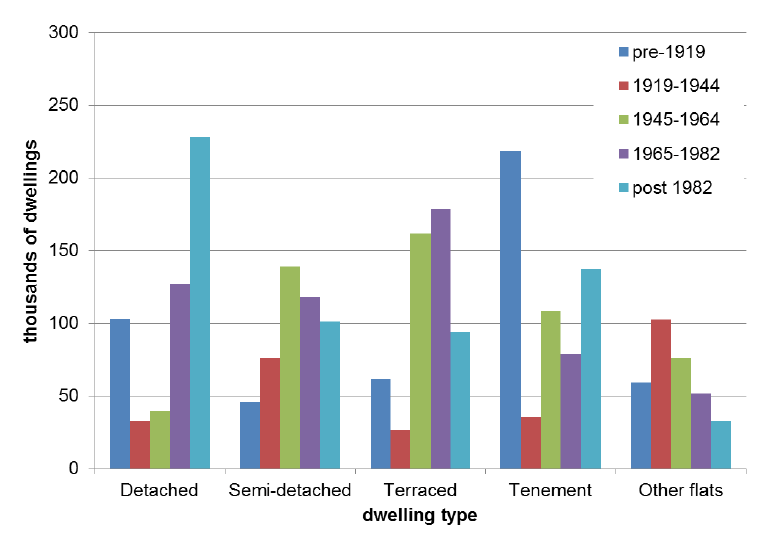
17. The proportion of the stock in each dwelling age band and type is provided in Table 1. Numbers of dwellings of each age group and type are shown in Table 2
Table 1: Proportion of Occupied Dwellings by Age Band and Type, 2015 (Percentage of Whole Stock)
| Age of dwelling | Type of Dwelling | |||||
|---|---|---|---|---|---|---|
| Detached | Semi-detached | Terraced | Tenement | Other flats | Total | |
| pre-1919 | 4% | 2% | 3% | 9% | 2% | 20% |
| 1919-1944 | 1% | 3% | 1% | 1% | 4% | 11% |
| 1945-1964 | 2% | 6% | 7% | 4% | 3% | 22% |
| 1965-1982 | 5% | 5% | 7% | 3% | 2% | 23% |
| post-1982 | 9% | 4% | 4% | 6% | 1% | 24% |
| Total | 22% | 20% | 21% | 24% | 13% | 100% |
| Sample size | 2,754 | |||||
Table 2: Number of Occupied Dwellings by Age Band and Type, 2015 (Thousands)
| Age of dwelling | Detached | Semi-detached | Terraced | Tenement | Other flats | Total |
|---|---|---|---|---|---|---|
| pre-1919 | 103 | 46 | 62 | 218 | 59 | 488 |
| 1919-1944 | 33 | 76 | 27 | 36 | 103 | 274 |
| 1945-1964 | 40 | 139 | 162 | 108 | 76 | 524 |
| 1965-1982 | 127 | 118 | 178 | 79 | 52 | 554 |
| post-1982 | 228 | 101 | 94 | 138 | 33 | 594 |
| Total | 531 | 480 | 522 | 579 | 322 | 2,434 |
| Sample size | 2,754 | |||||
18. The category 'other flats' includes houses that have been converted to flats (44,000), high rise blocks (55,000) and so-called "4-in-a-block" flats (223,000).
- "4-in-a-block" flats were commonly built as social housing between 1919 and 1965 (72% of all flats of this type fall in that age category).
- 86% of tower blocks were built in the 1945 to 1982 period, again often as social housing.
- Converted flats are almost exclusively pre-1919 structures (92%), where a house has been divided into multiple residences.
2.1.1 Dwelling Size (Floor Area)
19. The size of the internal floor area has implications for the heating requirements of a dwelling. Larger dwellings require greater heat inputs and therefore cost more to heat. This has a direct impact on fuel poverty (see Chapter 4).
Figure 2: Average Floor Area (m 2) by Dwelling Type and Age, 2015
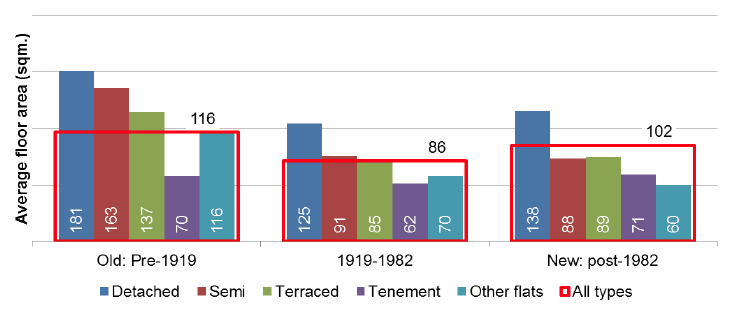
20. Pre-1919 dwellings tend to be larger than the other two age categories and this applies across all dwelling types except tenement flats which on average are comparable in size to more recently built ones ( Figure 2). Detached houses built after 1919 are on average around three-quarters of the size of those built pre-1919, while semi-detached and terraced houses are on average between just over half and two-thirds of their pre-1919 counterparts.
21. The overall average for post-1982 dwellings is somewhat higher compared to those built between 1919 and 1982. This is largely driven by differences in detached houses, which are both larger in size and more common in the post-1982 stock (see Table 2).
22. Rural dwellings are 39% larger than urban dwellings on average based on internal floor area, as shown in Table 3. The difference is smallest for dwellings built between 1919 and 1982 at 17%. Among older dwellings, rural properties are around 54% larger, while among the post-1982 stock the difference is close to the average at 36%.
Table 3: Average Internal Floor Area (m 2) by Urban/Rural Location, 2015
| Dwelling Age | Location | Rural % larger | ||
|---|---|---|---|---|
| Urban | Rural | All | ||
| Pre-1919 | 103 | 158 | 116 | 54% |
| 1919-1982 | 84 | 98 | 86 | 17% |
| Post-1982 | 95 | 129 | 102 | 36% |
| All Age Bands | 90 | 125 | 96 | 39% |
2.2 Gas Grid Coverage and Rural/Urban Location
23. Approximately 16% of dwellings in Scotland are estimated to be outside the coverage of the gas grid [8] . As shown in Table 4, the majority (93%) of urban dwellings are within the coverage of the gas grid, whereas over half (63%) of those in rural areas are not.
Table 4: Gas Grid Coverage Overall and by Urban/Rural Location, 2015
| Gas Grid Coverage | Location | |||||
|---|---|---|---|---|---|---|
| Urban | Rural | |||||
| 000s | % | 000s | % | 000s | % | |
| On Gas Grid | 2,038 | 84% | 1,887 | 93% | 150 | 37% |
| Off Gas Grid | 396 | 16% | 135 | 7% | 261 | 63% |
| Total | 2,434 | 100% | 2,022 | 100% | 412 | 100% |
| Sample size | 2,754 | 2,147 | 607 | |||
24. Connection to the grid allows households to use gas for heating and hot water. Gas is currently the cheapest of the major commercial fuels, so gas grid access can have a strong effect on the cost of heating a home.
25. Figure 3 shows the number of dwellings in rural and urban areas by type.
Figure 3: Dwelling Types in Rural and Urban Areas (000s), 2015
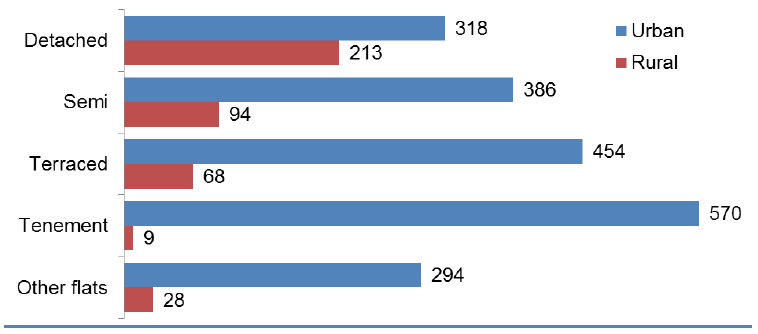
26. Just over half (213,000) of all rural dwellings are detached, and nearly a quarter (94,000) are semi-detached. Only 9% of rural dwellings are flats; 37,000 in total.
27. The most common dwelling type in urban areas is the tenement flat (570,000), accounting for around 28% of urban housing. Around 57% of urban stock are detached, semi-detached and terraced houses, in total accounting for over 1.2 million of the 2 million urban dwellings.
2.3 Heating Fuel
28. The primary heating fuel affects the cost of heating and therefore the energy efficiency of the dwelling and the risk of the occupants experiencing fuel poverty.
29. The relationship between the type of fuel used, the energy efficiency rating and fuel poverty will be explored further in later chapters. This section examines the distribution of dwellings in terms of the primary heating fuel used and a range of other characteristics.
30. Overwhelmingly the most common heating fuel is mains gas: 79% of Scottish households (around 1.9 million) use mains gas for heating, 12% use electricity and 7% use oil.
Table 5: Primary Heating Fuel, Households (000s) and %, for All Stock and by Sector, 2015
| All Stock | Private | Social | ||||
|---|---|---|---|---|---|---|
| Primary Heating Fuel | 000s | % | 000s | % | 000s | % |
| Mains gas | 1,914 | 79% | 1,446 | 78% | 468 | 79% |
| Electricity | 284 | 12% | 192 | 10% | 92 | 16% |
| Oil | 158 | 7% | 156 | 8% | * | * |
| Communal Heating | 25 | 1% | 5 | 0% | 21 | 3% |
| Solid mineral fuel | 18 | 1% | 16 | 1% | * | * |
| LPG bulk or bottled | 15 | 1% | * | * | * | * |
| Biomass | 15 | 1% | * | * | * | * |
| Other | - | - | - | - | - | - |
| Sample size | 2,754 | 2,095 | 659 | |||
* denotes cases where attributes appear too rarely to provide an adequate basis for reporting. See section 7.1.5 for table conventions
31. There is a greater diversity in fuels used in the private housing sector. Gas and electricity are used in 95% of social housing and around 3% (21,000 households) use some form of communal heating.
32. 82% of dwellings built between 1919 and 1982 use gas as their primary heating fuel. In comparison, 76% of dwellings built after 1982 use gas. Of the older dwellings, fewer use gas (73%) while electricity and other fuel types are more common (9% and 17% respectively).
33. Primary heating fuel also varies by type of dwelling. As shown in Table 6, households living in detached houses are least likely to use mains gas for heating: around two thirds (66%) of them do, compared to almost four out of five (79%) households for Scotland as a whole. This is largely because only around a third (35%) of pre-1919 detached houses have gas as their primary heating fuel; 54% use some other fuel source and 11% use electricity. As shown in Figure 3 and Table 4 this is due to the higher proportion of detached dwellings in rural areas which are not within the coverage of the gas grid.
34. "Other" fuels are most commonly used in detached houses across all age groups. Flats have the highest levels of electricity as primary heating fuel, especially among post-1919 dwellings.
Figure 4: Primary Heating Fuel by Age and Type of Dwelling, 2015 (percent of dwellings in age/type category using fuel type)
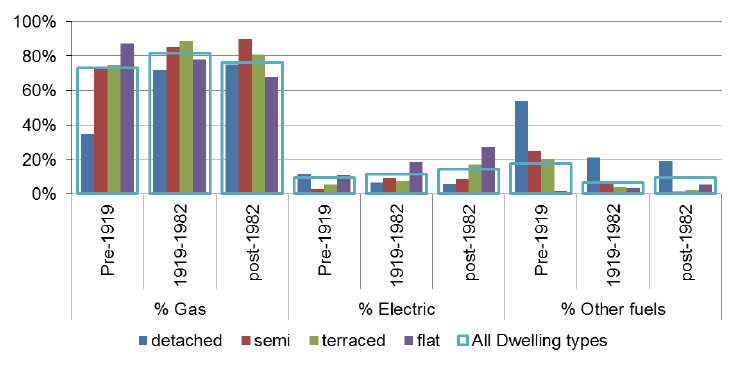
Table 6: Primary Heating Fuel by Age and Type of Dwelling, 2015
| Dwelling Type | Dwelling Age | Primary Heating Fuel | Sample size | ||
|---|---|---|---|---|---|
| Gas | Electric | Other | |||
| All Dwelling types | All age bands | 79% | 12% | 10% | 2,749 |
| pre-1919 | 73% | 9% | 17% | 487 | |
| 1919-1982 | 82% | 11% | 7% | 1,570 | |
| post-1982 | 76% | 14% | 9% | 692 | |
| Detached | All age bands | 66% | 7% | 27% | 692 |
| pre-1919 | 35% | 11% | 54% | 129 | |
| 1919-1982 | 72% | 7% | 21% | 274 | |
| post-1982 | 75% | 6% | 19% | 289 | |
| Semi | All age bands | 85% | 8% | 7% | 594 |
| pre-1919 | 72% | 3% | 25% | 57 | |
| 1919-1982 | 85% | 9% | 6% | 412 | |
| post-1982 | 90% | 9% | 1% | 125 | |
| Terraced | All age bands | 86% | 9% | 6% | 625 |
| pre-1919 | 75% | 5% | 20% | 71 | |
| 1919-1982 | 89% | 7% | 4% | 444 | |
| post-1982 | 81% | 17% | 2% | 110 | |
| Flat | All age bands | 79% | 18% | 3% | 838 |
| pre-1919 | 87% | 11% | 2% | 230 | |
| 1919-1982 | 78% | 18% | 3% | 440 | |
| post-1982 | 68% | 27% | 5% | 168 | |
2.4 Household Type
35. In this report we describe households in terms of three main types which are derived from the more detailed classification used in the Scottish Household Survey [9] :
- Families. These are households which contain at least one child aged under 16. The resident adults may be of any age.
- Older households. One- or two-member households which include at least one resident aged 65 or older.
- Other households. These are all other household types which are made up of adults only and have no resident children.
More details about the definitions are provided in section 7.5.2. This grouping differs from the one used in previous SHCS reports. The age threshold for older households used up until the 2014 Key Findings report was 60 for women and 65 for men, which reflected the prevalent state pension age for this period. As state pension age for women is gradually approaching that for men, for the current report we adopt 65 as the common age threshold for both men and women.
36. There is a broad association between household types and the type of dwellings they occupy, as shown in Figure 5 and Table 7. While families and older households are more likely to live in houses (74% and 69% respectively), other households are more evenly split between houses and flats (53% and 47% respectively).
37. Families have the highest occupancy of post-1982 dwellings, particularly houses: 27% of households with children live in post-1982 houses, compared with 13% of older households and 15% of other types of households. The highest occupancy of pre-1919 flats is observed among other types of households, 16%, compared to 7% for families and 8% for older households.
Figure 5: Proportion of Households in Each Dwelling Type and Age Band, 2015
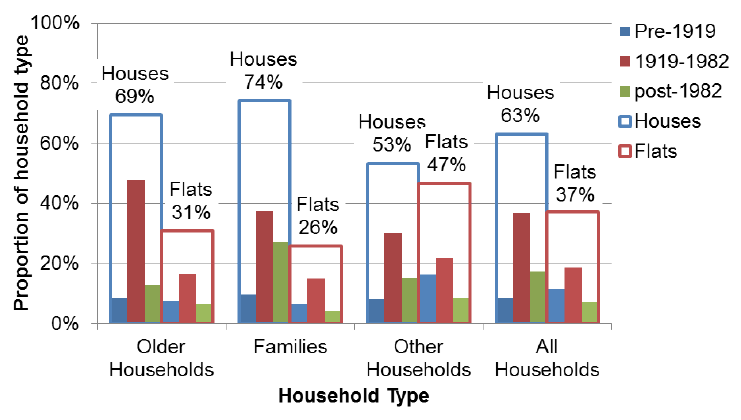
Table 7: Proportion of Households in Each Dwelling Type and Age Band, 2015
| Dwelling Type and Age Band | Older Households | Families | Other Households | All Household Types | |
|---|---|---|---|---|---|
| Houses | Pre-1919 House | 9% | 10% | 8% | 9% |
| 1919-1982 House | 48% | 37% | 30% | 37% | |
| Post-1982 House | 13% | 27% | 15% | 17% | |
| Subtotal | 69% | 74% | 53% | 63% | |
| Flats | Pre-1919 Flat | 8% | 7% | 16% | 11% |
| 1919-1982 Flat | 16% | 15% | 22% | 19% | |
| Post-1982 Flat | 7% | 4% | 9% | 7% | |
| Subtotal | 31% | 26% | 47% | 37% | |
| Total | 100% | 100% | 100% | 100% | |
| Sample size | 841 | 679 | 1,234 | 2,754 | |
2.5 Tenure
38. Statistics on tenure in the SHCS are based on the achieved sample of dwellings in the survey and are not calibrated against figures produced as part of the Scottish Government Housing Statistics for Scotland [10] publication. For estimates of the total number of dwellings by tenure, readers are referred to the Housing Statistics for Scotland publication which uses information from social landlords' returns covering the social housing sector comprehensively and therefore provides more accurate estimates of the total stock.
39. Data from the SHCS sample provides more detailed information on the composition of each tenure type. This is the topic we explore in this section.
2.5.1 Household Type and Tenure
Figure 6: Proportion of Households in Each Tenure Group by Household Type, 2015
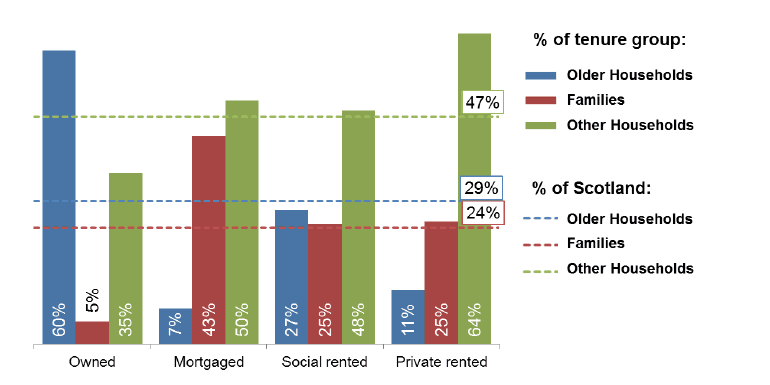
Note: Dashed lines represent the proportion of household type in Scotland as a whole.
40. There are some clear differences in household type across tenure, as shown in Figure 6.
41. Owner occupiers with mortgages are predominantly families (43%) and other households (51%), while those who own their properties outright are dominated by older households (60%) and other types of households (35%).
42. The majority of those who rent from private landlords ( PRS) belong to other households (64%) and only 11% are older households. A quarter of renters in both the private and the social sector are households with children, which reflects their share in the national population.
2.5.2 Dwelling Type and Tenure
43. Figure 7 shows that rented properties are more likely to be flats. Flats account for 53% of all Local Authority stock, 62% of Housing Association stock and 64% of dwellings rented from private sector landlords.
44. Owner-occupied dwellings are more likely to be houses, 80% of dwellings owned outright and 75% of those with a mortgage, compared to 47% of dwellings owned by Local Authorities, 38% of Housing Association stock and 36% of private rented properties
Figure 7: Proportion of Dwellings in Each Tenure Group by Age Band and Type of Dwelling, 2015
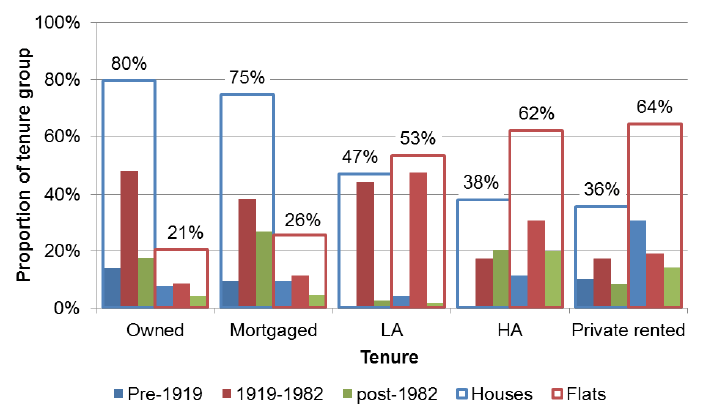
45. Almost all properties (91%) owned by Local Authorities ( LA) were built between 1919 and 1982, while about half (49%) of the Housing Associations ( HA) stock was built in this period and 40% are more recent. By contrast, 41% of private rented sector dwellings were built before 1919 ( Table 8).
Table 8: Proportion of Dwellings in Each Tenure Group, by Age Band and Type of Dwelling, 2015
| Dwelling Age and Type | Owned | Mort- gaged | LA | HA | Private rented | |
|---|---|---|---|---|---|---|
| Houses | Pre-1919 | 14% | 9% | - | - | 10% |
| 1919-1982 | 48% | 38% | 44% | 18% | 17% | |
| Post-1982 | 18% | 27% | 3% | 20% | 8% | |
| Subtotal | 80% | 75% | 47% | 38% | 36% | |
| Flats | Pre-1919 | 8% | 9% | 4% | 11% | 31% |
| 1919-1982 | 9% | 12% | 47% | 31% | 19% | |
| Post-1982 | 4% | 5% | 2% | 20% | 14% | |
| Subtotal | 21% | 26% | 53% | 62% | 64% | |
| Total | 100% | 100% | 100% | 100% | 100% | |
| Sample size | 929 | 811 | 380 | 279 | 355 | |
2.5.3 Household Income Band
46. As we might expect, income and tenure are closely correlated. For social sector residents the distribution is skewed towards lower income groups, as shown in Figure 8, while households with mortgages have the largest share of higher income groups.
47. The distribution of households by income in the private rented sector ( PRS) is broadly similar to that for outright owner occupiers. It is generally wider than the social housing sector, including significant shares of both higher and lower income band households.
Figure 8: Proportion of Households in Each Tenure Group by Weekly Household Income Band, 2015
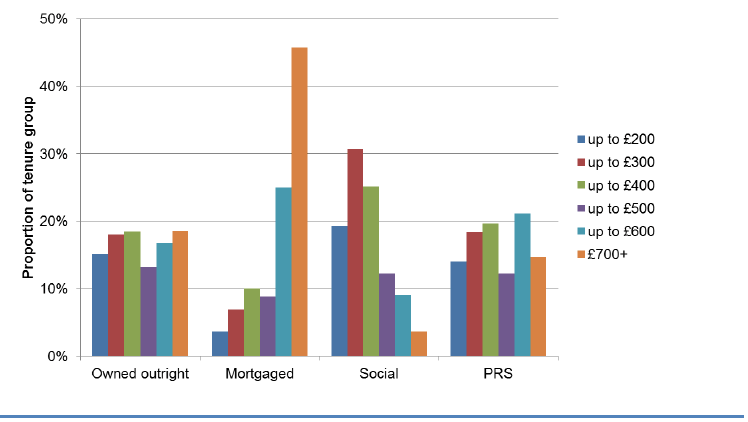
Contact
There is a problem
Thanks for your feedback